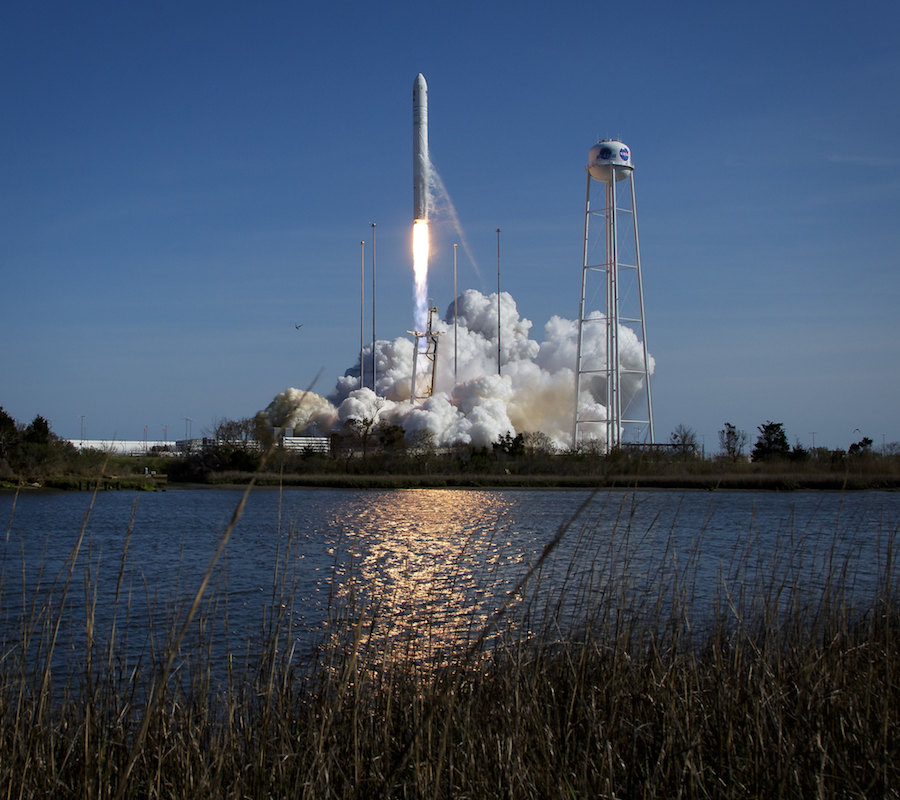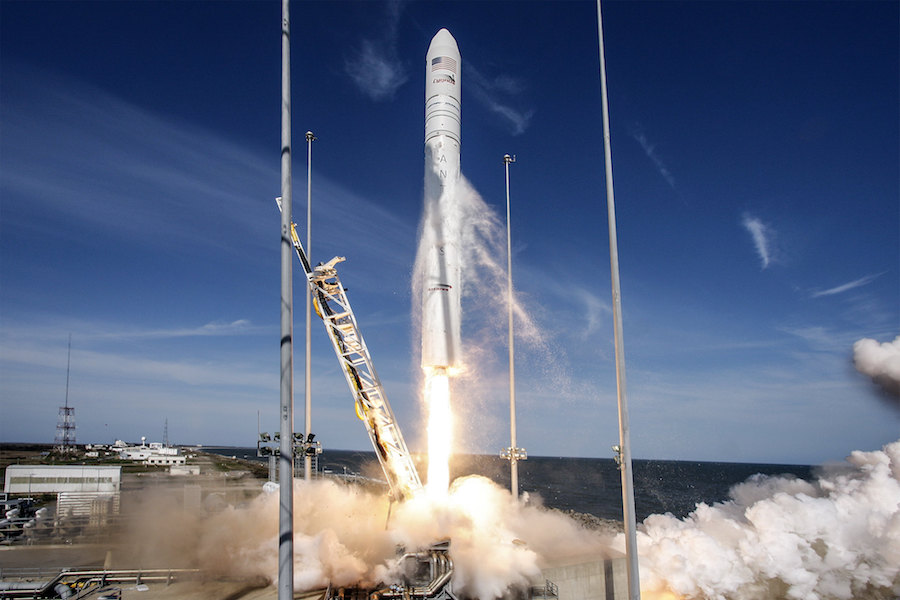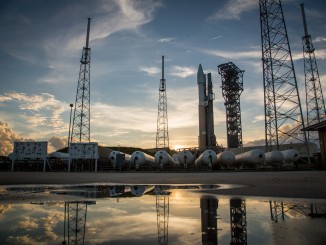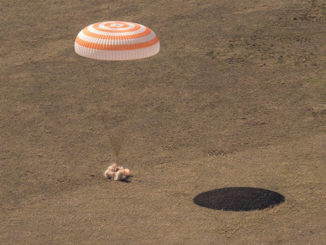
A commercial Cygnus cargo freighter packed with 3.8 tons of medical and pharmaceutical experiments, technology demonstration hardware, CubeSats, food and supplies rode an Antares rocket into orbit from Virginia’s Eastern Shore on Wednesday afternoon on the first leg of a day-and-a-half journey to the International Space Station.
The 139-foot-tall (42.5-meter) Antares rocket lit two Russian-made kerosene-fueled RD-181 main engines and climbed away from launch pad 0A at Wallops Island, Virginia, at 4:46:07 p.m. EDT (2046:07 GMT) Wednesday after a smooth countdown.
The two-stage launcher quickly rose from the launch pad overlooking the Atlantic Ocean, clearing four lightning masts within seconds as the first stage’s hydraulic steering system engaged to direct the rocket toward the southeast, aligning with the flight path of the space station.
The twin-engine first stage generated 864,000 pounds of thrust at full power and fired for 3 minutes, 35 seconds, before shutting down and dropping away to fall into the Atlantic. After a brief coast, the Antares rocket’s solid-fueled second stage ignited to send the Cygnus supply ship into orbit.
Northrop Grumman’s telemetry commentator confirmed an on-target separation of the 15,940-pound (7,230-kilogram) Cygnus spacecraft around nine minutes after liftoff, and officials declared the launch a success.
“Beautiful day, a fantastic launch,” said Joel Montalbano, NASA’s deputy program manager for the International Space Station. “It’s great to have another cargo vehicle on its way to the International Space Station.”

In a first, the Antares rocket carried 63 tiny student-built “ThinSats” as secondary payloads on the second stage. Strung together in groups of three or six, the ThinSats are each about the size of a slice of bread, containing solar cells to produce power, data transmitters and sensors to measure parameters such as temperatures and pressures.
The Antares upper stage deployed the ThinSats a few minutes after the Cygnus spacecraft — the mission’s primary payload — separated from the rocket.
Using a standardized form factor, children from middle school age to university students integrated sensor and transmitter hardware on the ThinSats with the support of the Virginia Commercial Space Flight Authority, Twiggs Space Lab, Northrop Grumman, and NASA’s Wallops Flight Facility.
“My whole passion in the industry and in academia is kids’ education,” said Bob Twiggs, co-inventor of the CubeSat and the ThinSat. “I got really turned on by being able to do something in space, and if you can get these kids turned on, boy, you’ve got to step out of the road, or they’re going to run right over the top of you.
“So doing something like this at a cost that you can get down into the elementary schools … I think is really great.”
Students from 70 schools in nine states contributed to the ThinSats launched Wednesday. Officials said they received telemetry signals from 43 of the ThinSats by Wednesday night, and more data was expected overnight into Thursday.
The ThinSats launched into an orbit with a perigee, or low point, of 125 miles (201 kilometers). At that altitude, aerodynamic drag will quickly cause the tiny spacecraft to fall back into the atmosphere and burn up, likely within five or 10 days. The quick decay alleviates concerns that the miniature satellites, which may be too small to be accurately tracked via radar, could pose an orbital debris hazard.

A slightly larger spacecraft, or CubeSat, named SASSI^2 separated from the Antares rocket’s upper stage with the ThinSats. Short for the Student Aerothermal Spectrometer Satellite of Illinois and Indiana, SASSI^2 carries instruments from the University of Illinois and Purdue University to measure pressure, heat flux and spectral data as the CubeSat encounters aerodynamic resistance in the upper atmosphere before it burns up on re-entry.
The Cygnus spacecraft activated its communications, propulsion and guidance and navigation systems moments after deploying from the Antares rocket, according to Frank DeMauro, vice president of Northrop Grumman’s space division.
The cargo freighter completed two orbit-raising burns shortly after separation from the Antares second stage, putting the spacecraft on course to arrive at the space station early Friday. The Cygnus also unfurled its two fan-shaped solar arrays to begin generating power, DeMauro said in a post-launch press conference.
The craft completed the two initial orbit-raising maneuvers autonomously using the supply ship’s on-board navigation computer, demonstrating a new capability that enables the Cygnus to reach the space station in a little more than 36 hours, instead of the more standard two or three days.
“We’re going from launch to being on the ISS in about a day-and-a-half, and one of the things that enables us to get there so quickly is those targeted altitude burns,” DeMauro said.
Using position fixes from GPS satellites and laser ranging data, the Cygnus supply ship will fly on autopilot during the final phase of Friday’s rendezvous with the space station. The spacecraft should be in a capture position around 30 feet (10 meters) below the station by 5:30 a.m. EDT (0930 GMT), when astronaut Anne McClain will use the Canadian-built robotic arm to grapple the Cygnus cargo freighter, which Northrop Grumman christened the “S.S. Roger Chaffee” in honor of the astronaut who perished with Gus Grissom and Ed White in the Apollo 1 fire in 1967.
The robot arm will place the Cygnus on the Earth-facing berthing port of the station’s Unity module, where the spacecraft will remain for around three months, allowing the station astronauts to unload equipment from its pressurized cabin, and replace the cargo with trash for disposal.
The Cygnus mission launched Wednesday, designated NG-11, carries 7,575 pounds (3,436 kilograms) of cargo, including new flying robots that could help astronauts with chores on the space station, medical experiments, and 40 mice to be studied by astronauts and researchers to examine how their immune systems cope with the conditions of spaceflight.
Around 6,971 pounds (3,162 kilograms) of food, crew provisions and science experiments are inside the Cygnus spacecraft’s cargo module, built by Thales Alenia Space in Italy, according NASA’s tally. The rest of the mission’s cargo load is mounted outside the spacecraft, where a NanoRacks CubeSat deployer will release three small nanosatellites after the supply ship departs the space station.

After release from the station’s robotic arm in July, the cargo craft will boost itself into a higher orbit for deployment of the CubeSats, similar to maneuvers accomplished by previous Cygnus missions. But instead of commanding the spacecraft to plunge back into the atmosphere for a destructive re-entry, Northrop Grumman ground controllers will oversee months of additional in-orbit experiments.
A package of four control moment gyroscopes is installed aboard the Cygnus spacecraft for the extended mission experiment. Using momentum to manage the spacecraft’s pointing, or attitude, the four spinning gyroscopes will reduce the Cygnus spacecraft’s consumption of liquid propellants, which feed thrusters normally used to change the supply ship’s orientation.
The innovation will allow the Cygnus spacecraft to remain in orbit for up to a year. Cygnus missions have previously lasted no more than three or four months.
“We’ll use the control moment gyros to control the spacecraft attitude, as opposed to fuel,” DeMauro said in an interview with Spaceflight Now before Wednesday’s launch.
Northrop Grumman officials previously said the extended mission demo could last a year, but DeMauro said the mission’s duration will depend on when engineers accomplish all their objectives.
“How long we go really will depend on when we achieve our goals for the extended mission (demonstration),” DeMauro said.
“We want to accomplish a couple of things,” he said. “First, we want to show how the spacecraft works with the CMGs (control moment gyroscopes) and demonstrate that our platform can use CMGs — not only our platform but other Northrop Grumman spacecraft platforms.
“The second thing we want to do is show that the avionics can run for extended period of time,” DeMauro said. “We’ve typically run them for several months as we’ve gone through testing, and then in orbit they run for three to four months, depending on how long we’re in orbit. This time, we want to demonstrate an even longer period of time that the computers run error-free, and that the attitude control system works just as expected.”
The control moment gyroscopes were built by Honeywell, using new miniaturized technology that could be used on future small satellites.
Northrop Grumman wants to keep the NG-11 Cygnus spacecraft in orbit through the launch of the company’s next resupply mission to the space station, designated NG-12, currently scheduled for October.
Officials want to offer future Cygnus spacecraft as a hosting platform for science and technology experiments after it leaves the space station. DeMauro said the Cygnus spacecraft provides a smooth microgravity environment for research in orbit, even better than the space station, which has disturbances from the movement of crew members and other external influences. The use of gyroscopes will make for more pristine microgravity conditions, eliminating impulses from thruster firings to change the ship’s orientation.
“The idea is that for future missions, we can outfit Cygnus to have the extended duration, and then after we complete the primary mission, offer this extended duration to either the government or commercial entities,” DeMauro said in an interview Tuesday with Spaceflight Now. “We want to give them enough time in orbit that isn’t restricted by when the next mission goes up, so having the ability to fly two Cygnus (spacecraft) in orbit at the same time is critical.”
Like past Cygnus missions, the spacecraft will re-enter the atmosphere and burn up over the Pacific Ocean once the extended duration demonstration is complete.
The NG-11 mission is the last Cygnus flight under Northrop Grumman’s first cargo transportation contract with NASA, a deal originally signed in 2008 now worth $2.89 billion, according to the Government Accountability Office. The company has a follow-on Commercial Resupply Services, or CRS-2, contract for at least six additional Cygnus missions through 2024, beginning with the NG-12 mission later this year.
“Our push is to offer NASA increased science capability on each mission,” DeMauro said.
For the first time on the NG-11 mission, ground teams at Wallops loaded time-sensitive cargo into the Cygnus spacecraft at the launch pad less than 24 hours before liftoff. Northrop Grumman developed a new Mobile Payload Processing Facility, or clean room, to place over the Antares rocket’s payload shroud after the launcher was lowered back to a horizontal position following preliminary pre-launch checkouts.
Technicians removed the top of the payload fairing, known as the “pop-top,” and opened the Cygnus hatch to allow teams to load the enclosure containing the rodent research experiment, along with a bio-analyzer experiment and other items. The NG-11 mission marks the first time a rodent research payload has flown aboard a Cygnus supply ship, following multiple missions on SpaceX’s Dragon cargo capsule.
The NG-11 launch Wednesday also debuted a new navigation system on the Antares rocket, ahead of additional launcher upgrades coming with the first CRS-2 mission later this year.
Engineers will beef up the Antares rocket’s structure for the next mission to allow the first stage’s twin RD-181 engines to remain at full throttle as the launcher flies through the most extreme period of aerodynamic pressure, or Max-Q, after liftoff. The engines are currently throttled back to around 55 percent power to ease the passage through Max-Q.
Northrop Grumman is also removing some unnecessary insulation from the inside of the Castor 30XL upper stage’s motor casing, and switching from a three-piece fairing adapter to a lighter single-piece structure. Future Antares rockets will also fly with two fewer helium pressurization bottles in the first stage. Data from previous launches indicated the rocket does not need the extra helium bottles.
The RD-181 engines will also launch without heat exchangers, which are designed to heat helium gas in flight. Northrop Grumman officials say the heat exchangers are not used by the Antares rocket.
The upgraded rocket will be known as the Antares 230+.
The changes will increase the mass of payloads the Antares rocket can loft into orbit by up to 1,763 pounds (800 kilograms), according to Kurt Eberly, vice president of the Antares program at Northrop Grumman.
“That will enable us to pack even more cargo into the cargo modules,” DeMauro said. “We’ve made some more modifications to be able to pack it more efficiently. That will be able to give us another 10 percent or so more cargo in the same volume.”
The Cygnus team has taken a step-by-step approach with upgrades since the spacecraft’s inaugural mission.
Since the Antares rocket and Cygnus spacecraft’s first missions in 2013, engineers from Northrop Grumman Innovation Systems — previously known as Orbital Sciences and Orbital ATK — have introduced a larger Thales-built cargo module and debuted new RD-181 engines for the Antares first stage. Officials replaced the Antares rocket’s original AJ26 first stage engines after one of the powerplants failed on a 2014 launch, destroying a Cygnus spacecraft heading for the space station and damaging the launch pad at Wallops Island.
DeMauro said the expanded performance and longer lifetime of the newest generation of Cygnus supply ships positions the spacecraft for more demanding missions in the future, including flights into deep space to support NASA’s plans to build a mini-space station called the Gateway in lunar orbit, with a goal set by the Trump administration of landing astronauts on the moon as soon as 2024.
“Going out to cislunar space will be a little bit different,” DeMauro said. “So we’ve looked at the avionics upgrades required for the higher radiation environment, different communications systems, docking versus berthing systems.”
Northrop Grumman has a NASA contract to develop a habitat concept based on the Cygnus design, which could be attached to NASA’s Gateway around the moon to provide living quarters for astronauts. Lunar landers could be staged at the Gateway for trips to and from the moon’s surface.
“We think we’re in a good place to offer NASA a proven, yet upgraded technology suite on a Cygnus-class vehicle to provide all sorts of services out in cislunar space, whether it’s habitats, logistics services, science and utilization services, as well as even power and propulsion systems out there. Cygnus is a stepping stone from that point of view,” DeMauro said.
“We can even expand that further and be part of the system to put people on the moon itself,” DeMauro said.
Grumman Aircraft Engineering Corp., which was purchased by Northrop Corp. in 1994 to form Northrop Grumman, built the Apollo lunar landers.
“If you look at that expertise, and you combine it with our expertise with Cygnus, we know there is a lot of capability out there that we’re going to take advantage of,” DeMauro said. “So we have every expectation that we’re going to play a large role, not only in supporting crew that goes out to the moon, but being able to design, build and deliver something that actually brings people down to the moon, so we’re so excited about that future.”
Email the author.
Follow Stephen Clark on Twitter: @StephenClark1.



